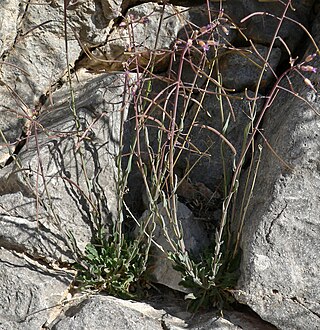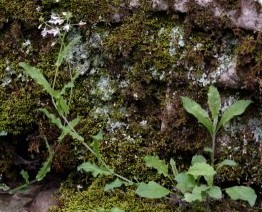
Arabis, or rockcress, is a genus of flowering plants, within the family Brassicaceae.

Boechera (rockcress) is a genus of the family Brassicaceae. It was named after the Danish botanist Tyge W. Böcher (1909–1983), who was known for his research in alpine plants, including the mustards Draba and Boechera holboellii. According to recent molecular-based studies, Boechera is closely related to the genus Arabidopsis which also includes the widely known model plant Arabidopsis thaliana.

Boechera gunnisoniana, or Gunnison's rockcress, is a perennial herb of the family Brassicaceae. It grows on windswept ridges as well as on stoney hillsides in west-central Colorado. The plant has many slender, erect stems which may reach a height of 15 cm. Flowering time is from May to June.

Boechera perennans is a species of rockcress known as perennial rockcress. It is native to the southwestern United States and northern Mexico. This rockcress forms several erect stems reaching past half a meter in height at maximum. The basal leaves may be several centimeters long and are hairy and often toothed, while the scattered upper leaves are smaller. Toward the top of the stem are small widely spaced purple or pink-purple flowers on long, thin stalks. These give way to the fruits, which are siliques: long, very narrow pods up to 6 centimeters long.
Boechera cobrensis is a species of flowering plant in the mustard family known by the common names Masonic rockcress and sagebrush rockcress. It is native to the western United States from eastern California to Wyoming, where it is found in sandy habitat, especially sagebrush. This is a perennial herb growing several erect, slender stems to heights near half a meter from a branching caudex. The plant forms a narrow clump with a base of narrow, linear, densely hairy leaves up to 5 centimeters long. There are also a few slightly shorter leaves clasping the stems at intervals. The top of each stem is occupied by an inflorescence of small, nodding flowers with dull yellowish sepals and white petals. The flowers give way to fruits which are narrow, straight siliques up to 4 centimeters long containing winged seeds.

Boechera stricta is a species of flowering plant in the mustard family known by the common name Drummond's rockcress. It is native to much of North America, including most of Canada, and the western and northeastern United States.

Boechera hoffmannii is a rare species of flowering plant in the family Brassicaceae known by the common name Hoffmann's rockcress. It is endemic to the Channel Islands of California, where it is known from only three or four populations on two of the eight islands. A 2005 report estimated a remaining global population of 244 individual plants. It is a federally listed endangered species.

Arabis lemmonii is a species of flowering plant in the family Brassicaceae known by the common name Lemmon's rockcress. It is native to western North America from Alaska to California to Colorado, where it grows in a number of rocky habitat types.

Boechera breweri is a species of flowering plant in the family Brassicaceae known by the common name Brewer's rockcress.
Boechera constancei is a species of flowering plant in the mustard family known by the common name Constance's rockcress. It is endemic to California, where it is known only from the northern Sierra Nevada of Plumas and Sierra Counties. It is a member of the serpentine soils flora. This is a perennial herb growing from a branching, woody caudex. It produces one or more erect, hairless stems to maximum heights between 15 and 30 centimeters. The caudex is surrounded by a dense basal rosette of stiff, blue-green, lance-shaped leaves up to 3 centimeters long. There may be a few smaller leaves along the stem. The inflorescence produces 5 to 10 white mustardlike flowers with protruding stamens. The fruit is a hanging green silique 4 or 5 centimeters long which contains round, winged seeds.
Boechera dispar is a species of flowering plant in the family Brassicaceae known by the common name pinyon rockcress. It is native to eastern California and western Nevada, where it grows in rocky areas in desert and mountain habitat. This is a perennial herb growing from a branching caudex. It produces several erect stems reaching 10 to 25 centimeters tall. The leaves are mostly located about the caudex. They are linear to lance-shaped, coated in white hairs, and one or two centimeters long. The flowers have purple petals. The fruit is a long, narrow, hairless silique up to 7 centimeters long containing round, winged seeds.

Sisymbrium orientale is a species of flowering plant in the family Brassicaceae known by the common names Indian hedgemustard and eastern rocket. It is native to Europe, Asia, and North Africa, and it can be found throughout much of the temperate world as an introduced species and in some areas a common roadside weed. It is an annual herb producing a hairy, branching stem up to about 30 centimeters tall. The basal leaves are divided into deep lobes or toothed leaflets. Leaves higher on the stem have lance-shaped blades with small separate lobes near the base. The top of the stem is occupied by a raceme of flowers with light yellow petals each measuring up to a centimeter long. The fruit is a silique which can be up to 10 centimeters long.
Boechera yorkii is a rare species of flowering plant in the mustard family known by the common name Last Chance rockcress. It is endemic to Inyo County, California, where it is known only from the Last Chance Range in Death Valley National Park. There are only two occurrences known, but the plant occurs in remote, nearly inaccessible mountain territory, so more plants may exist unobserved. The species was only described to science in 2004. Its habitat is rocky mountain canyons on cliffs of dolomite.

Boechera perstellata is a rare species of flowering plant in the mustard family known by the common names Braun's rockcress and Nevada rockcress. It is native to Kentucky and Tennessee, where it is known from perhaps 25 total populations. Most of the occurrences have few individuals, and all are deteriorating in quality. The plant grows in shady forest habitat on limestone substrates, usually near streams or rivers. This is a federally listed endangered species of the United States.
Boechera falcatoria is a rare species of flowering plant in the family Brassicaceae known by the common name Grouse Creek rockcress. It is endemic to Utah in the United States, where it is known only from Box Elder County. It has been reported from neighboring Nevada, but these reports are likely based on misidentifications.
Boechera ophira is a rare species of flowering plant in the mustard family known by the common name Ophir Pass rockcress, or Ophir rockcress. It is endemic to Nevada in the United States, where it is known from Nye and Lander Counties. It grows on the crest of the Toiyabe Range.
Boechera fecunda is a species of flowering plant in the mustard family known by the common names Mt. Sapphire rockcress and bitterroot rockcress. It is endemic to Montana in the United States, where there are twenty known occurrences in three counties.

Setaria palmifolia is a species of grass known by the common names palmgrass, highland pitpit, hailans pitpit, short pitpit, broadleaved bristlegrass, and knotroot. In Spanish it is called pasto de palma and in Samoan vao 'ofe 'ofe. It is native to temperate and tropical Asia. It is known elsewhere as an introduced, and often invasive, species, including in Australia, New Zealand, many Pacific Islands, and the Americas.

Boechera dentata, commonly called Short's rockcress, is a species of flowering plant in the mustard family (Brassicaceae). It is native to the eastern North America, where it is found in Canada and the United States. In the United States, its range is primarily centered in the Midwest, and in Canada it is only known from Ontario. Its natural habitat is in nutrient-rich alluvial forests and loamy bluffs, often on calcareous substrate.











